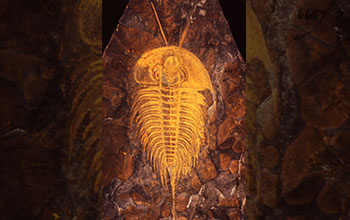Multimedia Gallery
Early Cambrian trilobite from Eastern Pennsylvania
A spectacular early Cambrian (515 million-year-old) trilobite Olenellus getzi from the Kinzers formation of eastern Pennsylvania. The creature lived during the Cambrian radiation, the time when animals first became abundant and started diversifying in the fossil record. One nice feature of this trilobite is that not only is the entire exoskeleton preserved, but there are also traces of the soft part appendages like the antennae. This is quite rare. This specimen is more than 15 centimeters long and is housed in the collections of the Yale Peabody Museum of Natural History.
This trilobite, along with many others, was considered in research funded by National Science Foundation grant EAR 01-06885. The research involved studying the evolutionary origins of the trilobites and considering the geological and climatic forces that may have led to the Cambrian radiation. (Date of Image: 2001)
Credit: Photo by Bruce S. Lieberman, University of Kansas
Images and other media in the National Science Foundation Multimedia Gallery are available for use in print and electronic material by NSF employees, members of the media, university staff, teachers and the general public. All media in the gallery are intended for personal, educational and nonprofit/non-commercial use only.
Images credited to the National Science Foundation, a federal agency, are in the public domain. The images were created by employees of the United States Government as part of their official duties or prepared by contractors as "works for hire" for NSF. You may freely use NSF-credited images and, at your discretion, credit NSF with a "Courtesy: National Science Foundation" notation.
Additional information about general usage can be found in Conditions.
Also Available:
Download the high-resolution JPG version of the image. (1.0 MB)
Use your mouse to right-click (Mac users may need to Ctrl-click) the link above and choose the option that will save the file or target to your computer.



